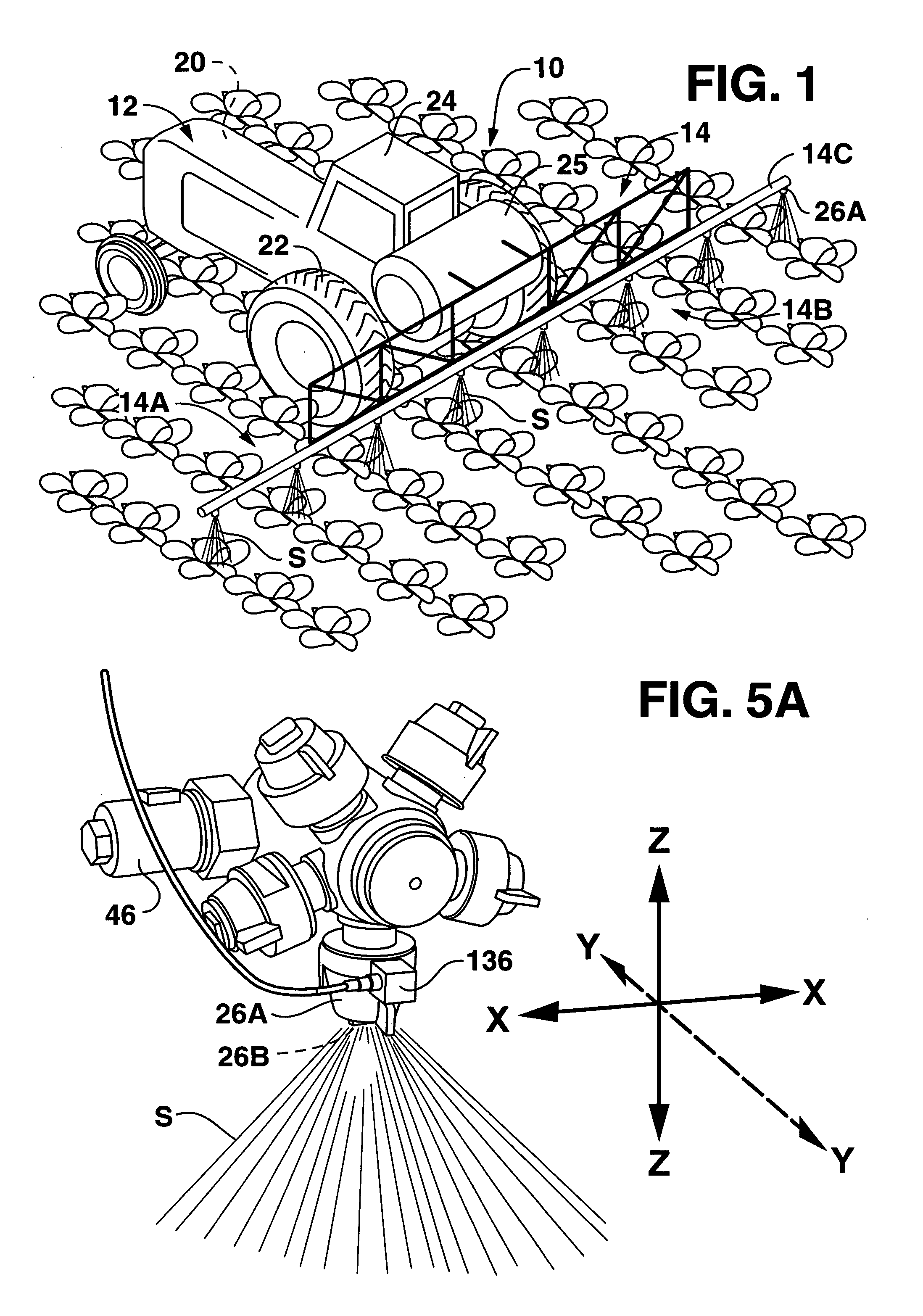Networked diagnostic and control system for dispensing apparatus
a networked diagnostic and control system technology, applied in the direction of ratio control, special dispensing means, special data processing applications, etc., can solve the problems of increasing the cost of agrochemicals and inadvertent spray drift or pesticide run-off, application errors that are significant yet unavoidable,
- Summary
- Abstract
- Description
- Claims
- Application Information
AI Technical Summary
Benefits of technology
Problems solved by technology
Method used
Image
Examples
example no.1
EXAMPLE NO. 1
[0102] Characteristic vibration of the spray atomization process was investigated using a single nozzle test stand, a multiple nozzle test stand and a commercial, self-propelled field sprayer (Case 4260, CNH Global). The single nozzle test stand used air-pressured canisters for liquid flow; this eliminated any vibration from pumps and bypass flow in the system. The multiple (3) nozzle test stand used an electric vane pump and allowed various configurations of pulsing flow to be generated. Data from the multiple (3) nozzle test stand were compared to the single nozzle stand. Pump and pipe flow vibrations were not found to affect the nozzle vibration measurements. Detailed results of the testing are provided in the report, “Sensing Spray Nozzle Vibration as a Means for Monitoring Operation,” by D. K. Giles, presented at ILASS Americas, 17th Annual Conference on Liquid Atomization and Spray Systems, Arlington, Va., May 2004.
[0103] The primary instrument for data collectio...
example no.2
EXAMPLE NO. 2
[0116] The nozzle control and monitor system depicted in FIGS. 2, 3 and 4 was installed on a self-propelled sprayer and operated while spraying a fallow field. The spray boom was outfitted with the system components and tested with flat fan agricultural spray nozzles. For the tests reported here, the nozzle used was a 110-degree nozzle with a flow rate of 0.6 gpm when operated at 40-psi liquid pressure. During the operation, the Fourier transformed vibration was recorded from each sensor at approximately one-second intervals; the average vibration and the standard deviation of the vibration value was calculated for all the nozzles. Vibration was linearly scaled to arbitrary units.
[0117] A number of typical conditions were tested and the results are shown in FIG. 7A for the specific conditions described in FIG. 7B. The test numbers in the horizontal axis of FIG. 7A correspond to the test numbers in the leftmost column of FIG. 7B. Performance of the system can be evaluat...
example no.3
EXAMPLE NO. 3
[0121] In addition to monitoring the proper operation of spray nozzles in a spraying system, the technique can be used to monitor the proper operation of other flow components, such as filters and pumps. While the monitoring of rotational components such as bearings, fans and the like by vibration is a technique well known in the art, the use of vibration as a means to detect partial clogging of a liquid system filter is an integral and new capability for the networked spray monitor.
[0122] The technique was investigated as a clogged filter detector. An accelerometer was coupled to the base of a common agricultural spray filter housing (1″ Arag filter housing). Clogged filter elements were then created by coating a portion of the filter element with epoxy glue to create an impassible flow path. The filter was supplied with pressurized water at 60 psi and the resulting vibration for each condition (0%, 50%, 75% and 100% clogged filters) was recorded. The resulting data i...
PUM
 Login to View More
Login to View More Abstract
Description
Claims
Application Information
 Login to View More
Login to View More - R&D
- Intellectual Property
- Life Sciences
- Materials
- Tech Scout
- Unparalleled Data Quality
- Higher Quality Content
- 60% Fewer Hallucinations
Browse by: Latest US Patents, China's latest patents, Technical Efficacy Thesaurus, Application Domain, Technology Topic, Popular Technical Reports.
© 2025 PatSnap. All rights reserved.Legal|Privacy policy|Modern Slavery Act Transparency Statement|Sitemap|About US| Contact US: help@patsnap.com



